So, after a couple days of fighting with it, I think I finally have the Alpine Butterfly figured out.
(Disclaimer: I might still be wrong. Please don't try to learn knots from me, then sue me if you fall off a mountain or something. Always learn from someone who actually knows what they'll doing.)
 |
| This fucking knot(butterfly) |
What's it for: Putting loop(s) in the middle of a line. Unlike the bowline (the most famous loop making knot) you can easily put as many as you want wherever you want in the rope. You could even make an absolute ton to make a whole ladder of hand and footholds. That's pretty cool.
Why is it such a pain? There are some pretty common issues with learning new knots. How symmetrical is it? What happens if you mess it up? How many ways to tie it are there?
For the Butterfly, the answers are pretty much universally, "whatever the worst answer is."
How symmetrical? Not even a little. Front to back, left to right, up to down. No matter how you tie it or look at it, any change in direction changes it. Sometimes it's only cosmetic, but sometimes it will ruin the knot. There's not even really a consensus on which side is the front and which is the back. This is made even worse by the fact that a lot of websites, books, etc. will do things like show you the correct way for one side to look and the incorrect for another. I shouldn't have to cludge together four images from three sources to figure out what a knot should look like!
What happens if you mess it up? You get a "false butterfly" which looks and works very similarly. It will fail under a sufficient load, and the visual differences are pretty minor. Compare that to some of the other knots that I worked on this month: if your bowline slides, it's not a bowline. If your reef knot doesn't interlock nice and symmetrically, it's a granny knot. The false butterfly requires careful inspection from both sides, or a heavy load test.
How many ways to tie? Most knots can be tied multiple ways, but usually there's one "main" way or the differences are very small. The butterfly has two completely different but equally popular ways, plus an almost as popular "hybrid" approach, along with assorted sub variants. That's fine, as long as you know which way you're tying it, but if you're trying to double check you have to make sure you're double checking against another set of instructions for the same variant.
Basically, trying to learn the butterfly almost felt like trying to learn 4 or 5 knots at once, until I figured out how to "align" them figure out what went with what. I'm pretty sure I was tying them mostly correctly much earlier, but couldn't tell since I'd look online and go, "nope, that's different" when I was looking at one tied the opposite direction or something and it was fine.
I'm trying all my own pics for this one. Partially just to have something different, and partially because of the aforementioned issues with finding good pics of the finished knot.
How to tie:
1. Put two twists in the rope. ALWAYS go from the same side over the opposite, eg left over right, left over right again. DO NOT always put the same end over eg left over right, right over left.
 |
| Step 1 |
2. Bend the top loop over the bottom loop, between the ends of the rope.
 |
| Step 2 |
3. Come up through the second loop from the back. Pull the ends to tighten.
 |
| Step 3 |
 |
| Correct "Front" |
For my purposes, this is the "front" of the knot. It has the "wings" of the butterfly mostly vertical, both wrapped the same way around the rope. The inner parts look parallel here, but this is NOT a requirement for a "correct" butterfly as far as I can tell.
 |
| Incorrect "Front" |
 |
| Right "Back" |
 |
| Wrong "Back" |
There's the Alpine Butterfly. I spend more time learning this knot than learning and relearning all the others put together. Not sure it was worth it, but it's always good to learn something new.



No comments:
Post a Comment